0 引言
1 样品和实验
1.1 样品特征
图1 沁水盆地构造区域图(a)和地层柱状图(b)Fig.1 Schematic maps showing the structural framework (a) of the Qinshui Basin and the stratigraphic column (b) of the basin |
表1 榆社区块太原组煤系页岩的地质地球化学特征和含水量Table 1 Geochemical characteristics and water content of the shales from the coal-bearing Taiyuan Formation in the Yushe area |
| 样品号 | 深度 /m | 层位 | 岩石热解(Rock-Eval) | 矿物组分/% | 镜质体 反射率 /% | 含水量/ (mg/g) | ||||||||
|---|---|---|---|---|---|---|---|---|---|---|---|---|---|---|
| T max/°C | I H/(mg/gTOC) | I O/(mg/gTOC) | TOC/% | 石英 | 黏土矿物 | 白云石 | 菱铁矿 | 黄铁矿 | ||||||
| 伊利石 | 高岭石 | |||||||||||||
| YS-1 | 1 941.96 | 太原组 | 592 | 9 | 26 | 4.21 | 30.6 | 23.1 | 19.0 | 5.0 | 15.2 | 7.1 | 3.28 | 3.55 |
| YS-2 | 1 944.17 | 太原组 | 596 | 14 | 2 | 9.88 | 16.4 | 16.1 | 58.0 | 4.0 | 4.5 | 1.0 | — | 4.37 |
| YS-3 | 1 947.69 | 太原组 | 597 | 13 | 6 | 12.65 | 38.0 | 10.5 | 47.6 | 2.2 | 1.7 | 0.0 | 3.25 | 2.43 |
| YS-4 | 1 949.54 | 太原组 | 597 | 7 | 9 | 1.15 | 63.0 | 2.2 | 9.9 | 7.8 | 8.6 | 8.5 | — | 0.60 |
| YS-5 | 1 952.45 | 太原组 | 603 | 9 | 18 | 7.39 | 56.9 | 6.8 | 13.8 | 5.7 | 12.0 | 4.8 | 3.30 | 1.99 |
| YS-6 | 1 956.36 | 太原组 | 601 | 8 | 11 | 1.52 | 20.6 | 50.1 | 22.0 | 4.7 | 0.8 | 1.8 | — | 3.22 |
|
1.2 实验方法
1.2.1 孔隙度测定
1.2.2 低温低压气体吸附实验
2 结果和讨论
2.1 煤系页岩的含水量及其主控因素
2.2 页岩的孔隙度和孔径分布
表2 榆社区块YS-X井太原组煤系页岩孔隙度以及在干燥和实取状态下孔隙结构特征Table 2 The porosity, and the pore volume and surface area on the dry and as-received condition of the shales from the coal-bearing Taiyuan Formation in the Well YS-X of the Yushe area |
| 样品号 | 深度/m | 孔隙度/% | 干燥状态 | 实取(含水)状态 | ||||||||||
|---|---|---|---|---|---|---|---|---|---|---|---|---|---|---|
| 孔容/(cm3/g) | 比表面积/(m2/g) | 孔容/(cm3/g) | 比表面积/(m2/g) | |||||||||||
| 微孔 | 非微孔 | 总孔 | 微孔 | 非微孔 | 总孔 | 微孔 | 非微孔 | 总孔 | 微孔 | 非微孔 | 总孔 | |||
| YS-1 | 1 941.96 | 2.62 | 0.006 | 0.020 | 0.026 | 15.22 | 14.11 | 29.33 | 0.004 | 0.009 | 0.013 | 10.48 | 1.97 | 12.45 |
| YS-2 | 1 944.17 | 4.77 | 0.019 | 0.013 | 0.031 | 46.25 | 10.41 | 56.66 | 0.010 | 0.007 | 0.017 | 26.30 | 2.15 | 28.46 |
| YS-3 | 1 947.69 | 4.68 | 0.026 | 0.009 | 0.035 | 66.19 | 14.26 | 80.44 | 0.010 | 0.007 | 0.017 | 27.50 | 2.98 | 30.48 |
| YS-4 | 1 949.54 | 1.20 | 0.004 | 0.008 | 0.013 | 10.03 | 3.76 | 13.78 | 0.001 | 0.007 | 0.008 | 3.66 | 2.40 | 6.06 |
| YS-5 | 1 952.45 | 4.13 | 0.006 | 0.016 | 0.021 | 14.04 | 10.55 | 24.60 | 0.003 | 0.007 | 0.010 | 7.17 | 2.42 | 9.59 |
| YS-6 | 1 956.36 | 4.63 | 0.006 | 0.019 | 0.026 | 15.29 | 13.52 | 28.81 | 0.004 | 0.007 | 0.012 | 10.65 | 1.68 | 12.33 |
图4 榆社区块YS-X井太原组煤系页岩样品在干燥和实取(含水)状态下页岩TOC含量与页岩微孔(a,d)、非微孔(b,e)和总孔(c,f)孔容和比表面积的相关性Fig.4 Correlations of the TOC content with the pore volume and surface area of the micropores (a, d), nonmicropores (b, e), and total pores (c, f) the on the dry and as-received condition of the shales from the coal-bearing Taiyuan Formation in the Well YS-X of the Yushe area |
图5 榆社区块YS-X井太原组煤系页岩样品在干燥和实取(含水)状态下黏土矿物含量与页岩微孔(a,d)、非微孔(b,e)和总孔(c,f)孔容和比表面积的相关性Fig.5 Correlations of the clay mineral content with the pore volume and surface area of the micropores (a,d), non-micropores (b, e), and total pores (c, f) the on the dry and as-received condition of the shales from the coal-bearing Taiyuan Formation in the Well YS-X of the Yushe area |
2.3 页岩中的水对其孔隙特征的影响
表3 榆社区块YS-X井太原组煤系页岩中的水对其孔容和比表面积的影响Table 3 The influences of the water on the pore volume and surface area for the shales from the coal-bearing Taiyuan Formation in the Well YS-X of the Yushe area |
| 样品号 | 深度/m | 孔容减小程度/% | 比表面积减小程度/% | ||||
|---|---|---|---|---|---|---|---|
| 微孔 | 非微孔 | 总孔 | 微孔 | 非微孔 | 总孔 | ||
| YS-1 | 1 941.96 | 29.2 | 52.9 | 47.2 | 30.5 | 86.1 | 57.4 |
| YS-2 | 1 944.17 | 32.9 | 48.4 | 39.6 | 42.5 | 79.0 | 49.2 |
| YS-3 | 1 947.69 | 61.8 | 11.4 | 47.8 | 58.5 | 79.6 | 62.3 |
| YS-4 | 1 949.54 | 66.2 | 16.6 | 34.5 | 63.1 | 40.7 | 56.9 |
| YS-5 | 1 952.45 | 53.3 | 57.8 | 56.7 | 48.8 | 78.2 | 61.4 |
| YS-6 | 1 956.36 | 27.5 | 61.4 | 53.2 | 32.5 | 88.5 | 58.6 |
图6 榆社区块YS-2煤系页岩样品在干燥和实取(含水)状态下N2吸附解析曲线(a)以及孔容(b)和比表面积(c)分布构型Fig.6 N2 gas adsorption and desorption isotherms (a), and surface area (b) and pore volume (c) distributions with pore size for the YS-2 shale sample from the coal-bearing Taiyuan Formation of the Yushe area on the dry and as-received conditions |
图7 榆社区块YS-2煤系页岩样品在干燥和实取(含水)状态下CO2吸附曲线(a)以及孔容(b)和比表面积(c)分布构型Fig.7 CO2 gas adsorption isotherms (a), and surface area (b) and pore volume (c) distributions with pore size for the YS-2 shale sample from the coal-bearing Taiyuan Formation of the Yushe area on the dry and as-received conditions |



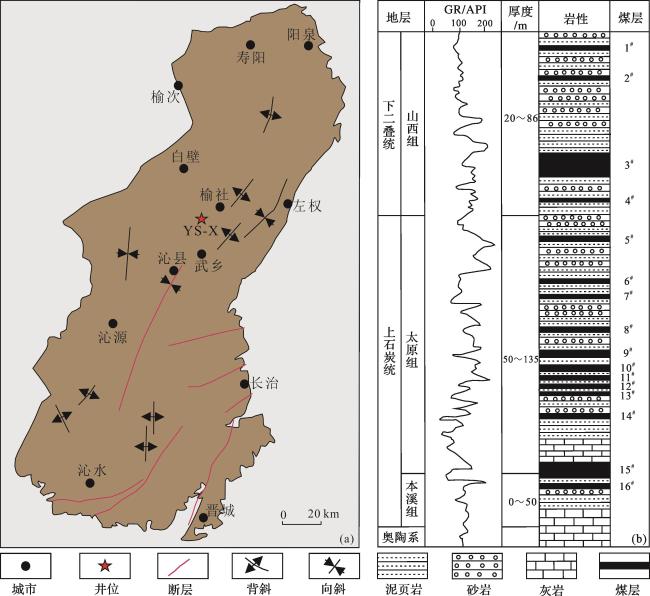


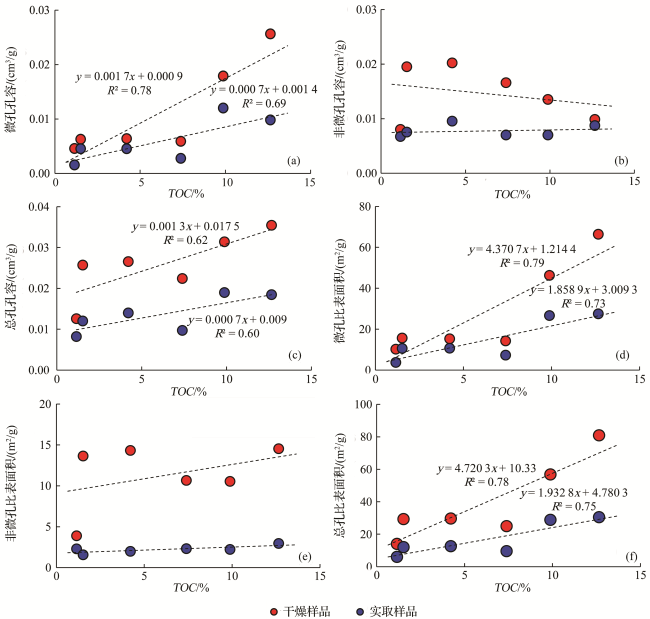
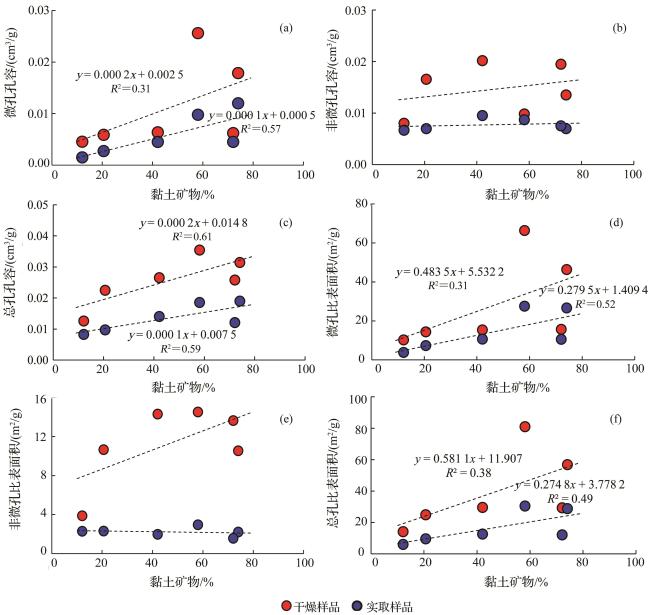
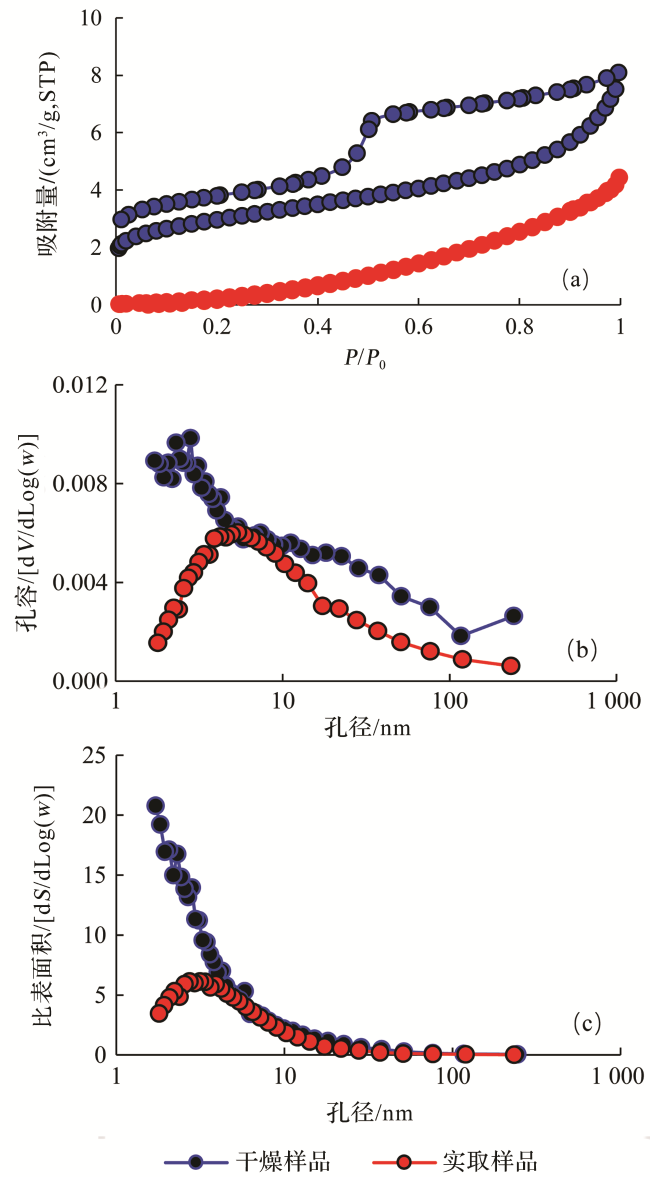
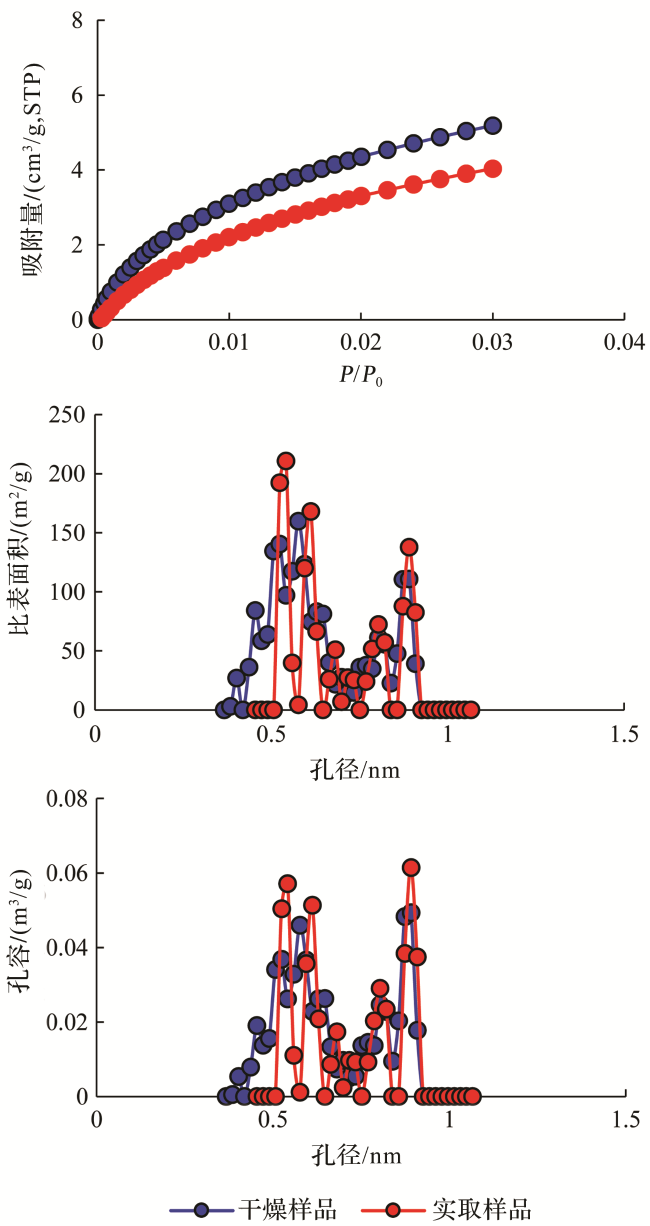
 甘公网安备 62010202000678号
甘公网安备 62010202000678号